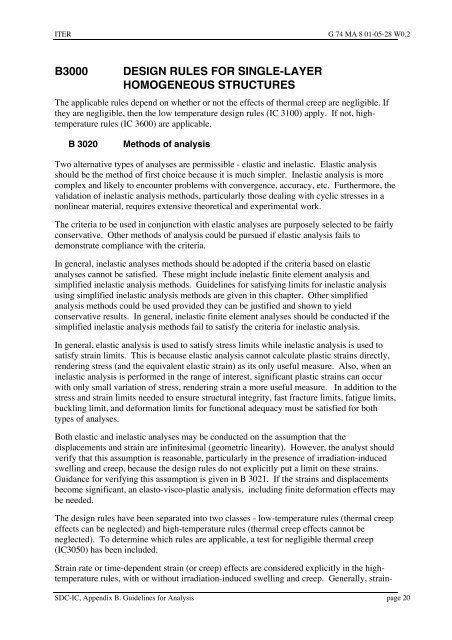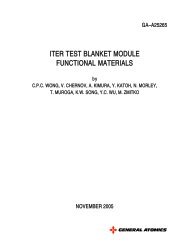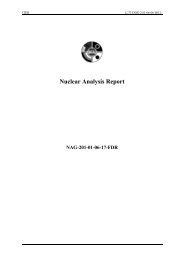iter structural design criteria for in-vessel components (sdc-ic)
iter structural design criteria for in-vessel components (sdc-ic)
iter structural design criteria for in-vessel components (sdc-ic)
You also want an ePaper? Increase the reach of your titles
YUMPU automatically turns print PDFs into web optimized ePapers that Google loves.
ITER G 74 MA 8 01-05-28 W0.2<br />
B3000 DESIGN RULES FOR SINGLE-LAYER<br />
HOMOGENEOUS STRUCTURES<br />
The appl<strong>ic</strong>able rules depend on whether or not the effects of thermal creep are negligible. If<br />
they are negligible, then the low temperature <strong>design</strong> rules (IC 3100) apply. If not, hightemperature<br />
rules (IC 3600) are appl<strong>ic</strong>able.<br />
B 3020 Methods of analysis<br />
Two alternative types of analyses are permissible - elast<strong>ic</strong> and <strong>in</strong>elast<strong>ic</strong>. Elast<strong>ic</strong> analysis<br />
should be the method of first cho<strong>ic</strong>e because it is much simpler. Inelast<strong>ic</strong> analysis is more<br />
complex and likely to encounter problems with convergence, accuracy, etc. Furthermore, the<br />
validation of <strong>in</strong>elast<strong>ic</strong> analysis methods, part<strong>ic</strong>ularly those deal<strong>in</strong>g with cycl<strong>ic</strong> stresses <strong>in</strong> a<br />
nonl<strong>in</strong>ear material, requires extensive theoret<strong>ic</strong>al and experimental work.<br />
The cr<strong>iter</strong>ia to be used <strong>in</strong> conjunction with elast<strong>ic</strong> analyses are purposely selected to be fairly<br />
conservative. Other methods of analysis could be pursued if elast<strong>ic</strong> analysis fails to<br />
demonstrate compliance with the cr<strong>iter</strong>ia.<br />
In general, <strong>in</strong>elast<strong>ic</strong> analyses methods should be adopted if the cr<strong>iter</strong>ia based on elast<strong>ic</strong><br />
analyses cannot be satisfied. These might <strong>in</strong>clude <strong>in</strong>elast<strong>ic</strong> f<strong>in</strong>ite element analysis and<br />
simplified <strong>in</strong>elast<strong>ic</strong> analysis methods. Guidel<strong>in</strong>es <strong>for</strong> satisfy<strong>in</strong>g limits <strong>for</strong> <strong>in</strong>elast<strong>ic</strong> analysis<br />
us<strong>in</strong>g simplified <strong>in</strong>elast<strong>ic</strong> analysis methods are given <strong>in</strong> this chapter. Other simplified<br />
analysis methods could be used provided they can be justified and shown to yield<br />
conservative results. In general, <strong>in</strong>elast<strong>ic</strong> f<strong>in</strong>ite element analyses should be conducted if the<br />
simplified <strong>in</strong>elast<strong>ic</strong> analysis methods fail to satisfy the cr<strong>iter</strong>ia <strong>for</strong> <strong>in</strong>elast<strong>ic</strong> analysis.<br />
In general, elast<strong>ic</strong> analysis is used to satisfy stress limits while <strong>in</strong>elast<strong>ic</strong> analysis is used to<br />
satisfy stra<strong>in</strong> limits. This is because elast<strong>ic</strong> analysis cannot calculate plast<strong>ic</strong> stra<strong>in</strong>s directly,<br />
render<strong>in</strong>g stress (and the equivalent elast<strong>ic</strong> stra<strong>in</strong>) as its only useful measure. Also, when an<br />
<strong>in</strong>elast<strong>ic</strong> analysis is per<strong>for</strong>med <strong>in</strong> the range of <strong>in</strong>terest, signif<strong>ic</strong>ant plast<strong>ic</strong> stra<strong>in</strong>s can occur<br />
with only small variation of stress, render<strong>in</strong>g stra<strong>in</strong> a more useful measure. In addition to the<br />
stress and stra<strong>in</strong> limits needed to ensure <strong>structural</strong> <strong>in</strong>tegrity, fast fracture limits, fatigue limits,<br />
buckl<strong>in</strong>g limit, and de<strong>for</strong>mation limits <strong>for</strong> functional adequacy must be satisfied <strong>for</strong> both<br />
types of analyses.<br />
Both elast<strong>ic</strong> and <strong>in</strong>elast<strong>ic</strong> analyses may be conducted on the assumption that the<br />
displacements and stra<strong>in</strong> are <strong>in</strong>f<strong>in</strong>itesimal (geometr<strong>ic</strong> l<strong>in</strong>earity). However, the analyst should<br />
verify that this assumption is reasonable, part<strong>ic</strong>ularly <strong>in</strong> the presence of irradiation-<strong>in</strong>duced<br />
swell<strong>in</strong>g and creep, because the <strong>design</strong> rules do not expl<strong>ic</strong>itly put a limit on these stra<strong>in</strong>s.<br />
Guidance <strong>for</strong> verify<strong>in</strong>g this assumption is given <strong>in</strong> B 3021. If the stra<strong>in</strong>s and displacements<br />
become signif<strong>ic</strong>ant, an elasto-visco-plast<strong>ic</strong> analysis, <strong>in</strong>clud<strong>in</strong>g f<strong>in</strong>ite de<strong>for</strong>mation effects may<br />
be needed.<br />
The <strong>design</strong> rules have been separated <strong>in</strong>to two classes - low-temperature rules (thermal creep<br />
effects can be neglected) and high-temperature rules (thermal creep effects cannot be<br />
neglected). To determ<strong>in</strong>e wh<strong>ic</strong>h rules are appl<strong>ic</strong>able, a test <strong>for</strong> negligible thermal creep<br />
(IC3050) has been <strong>in</strong>cluded.<br />
Stra<strong>in</strong> rate or time-dependent stra<strong>in</strong> (or creep) effects are considered expl<strong>ic</strong>itly <strong>in</strong> the hightemperature<br />
rules, with or without irradiation-<strong>in</strong>duced swell<strong>in</strong>g and creep. Generally, stra<strong>in</strong>-<br />
SDC-IC, Appendix B. Guidel<strong>in</strong>es <strong>for</strong> Analysis page 20




